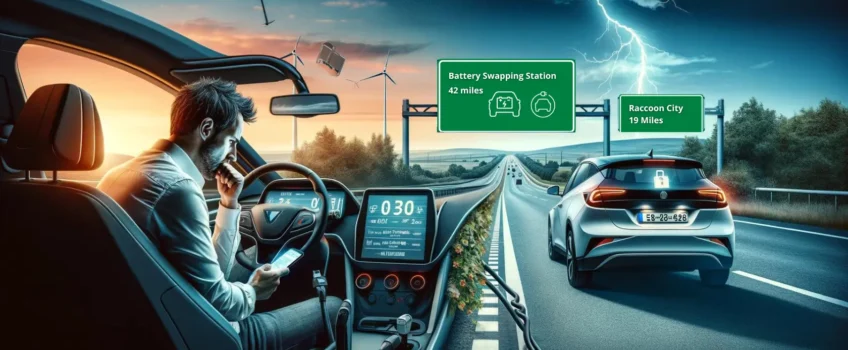
EV battery swapping is currently a hot topic, and rightfully so, given the remarkable progress of electric vehicles since their inception. With advancements in battery tech, EVs now boast extended ranges and quicker charging, making them a more practical choice for daily driving. Nonetheless, concerns like range anxiety and lengthy charging times still hinder widespread adoption. This is where EV battery swapping technology shines, offering a solution that tackles both challenges head-on.
How Does Battery Swapping Work?
EV battery swapping typically involves three main components – the EV, the battery pack, and the swapping station. The EV must be designed with a removable battery pack, which can be easily accessed and removed. At the swap station, the depleted battery pack is removed from the EV and replaced with a fully charged one. The entire process can take as little as five minutes, making it much faster than traditional charging methods.
Advantages of Battery Swapping
Battery swapping technology has the potential to revolutionise e-mobility and accelerate EV adoption for several reasons:
- Faster Charging Time: With battery swapping, drivers can have their depleted battery pack replaced with a fully charged one in a matter of minutes, eliminating the need to wait hours for a charge.
- Eliminates Range Anxiety: Drivers can simply swap out their depleted battery pack for a fully charged one at any station along their route, eliminating the fear of running out of power mid-journey.
- Cost Savings: By eliminating the need for individual charging stations, infrastructure costs are significantly reduced. Additionally, battery swapping allows for more efficient use of batteries and reduces the need for expensive fast-charging infrastructure.
- Easier Adoption: For those hesitant to go electric to concerns about charging, battery swapping provides a more convenient and familiar ‘refuelling’ experience. This makes the transition to e-mobility easier for early adopters and those who are new to EVs.
Challenges of Battery Swapping
While battery swapping offers many benefits, there are challenges that need to be addressed for it to become a widespread solution:
- Compatibility: As battery technology continues to evolve, compatibility between different EV models and battery packs may become an issue. To address this, industry-wide standardisation of batteries may be necessary.
- Infrastructure: Battery swapping stations require significant infrastructure investments, including the installation of specialised equipment and maintenance costs. This can pose a challenge in areas with lower EV adoption rates.
- Logistics: The logistics of swapping out large and heavy battery packs can be complex. This is especially true for larger vehicles like lorries (trucks) and buses, which require more powerful and specialised equipment.
The Evolution Of Electric Vehicles and Battery Swapping
Electric vehicles and their journey through time stand as a testament to human innovation, tracing back almost as far as the automobile itself. With the Flocken Elektrowagen rolling out in 1888, merely two years after the debut of the Benz Patent Motor Car, the inception of electric mobility was marked. Amidst this historical backdrop, John de Souza, Co-founder and President of Ample, underscores a parallel narrative — the enduring legacy of EV battery swapping within the automotive realm. According to de Souza, who spoke at the 2018 Geneva International Motor Show, battery swapping is not a new concept in itself but rather an idea that has evolved with time.
At its inception, the concept of EV battery swapping was straightforward: exchange depleted batteries for fully charged ones and resume driving. However, with technological advancements, the idea of battery swapping has evolved. In recent times, companies such as Ample have introduced sophisticated robotics and software to enhance the speed, efficiency, and compatibility of battery swapping with a range of EV models.
The Resurgence of EV Battery Swapping in Modern Times
In 1943, Spain proposed an initiative for a fully electric taxi fleet, showcasing an early inclination towards electric mobility. Yet, the lengthy charging times posed a significant hurdle, birthing the concept of battery swapping. Operators could replace a depleted battery with a fully charged one within a mere five minutes, streamlining operations and setting a precedent for future mobility solutions. However, the subsequent dip in fuel prices diverted the course, relegating EVs and the concept of battery swapping to the fringes of automotive innovation.
In 2008, Better Place, a startup that aimed to deploy an extensive network of battery swapping stations globally, garnered significant investments. However, financial struggles led to its bankruptcy in 2013. Tesla also experimented with battery swapping for their Model S in 2013 but ultimately shifted their focus to expanding their Supercharger network.
The Future of Electric Mobility
Today, we see a resurgence of interest in EV battery swapping, driven by advancements in technology and consumer demand for efficient and convenient charging solutions. Companies like Ample, Tesla, NIO, and Gogoro are leading the charge (pun intended) with innovative approaches to battery swapping. They aim to reduce charging times and range anxiety, making electric mobility a more viable option for the masses.
Among many examples of impressive initiatives is the integration of Ample’s battery swapping technology. This, in itself, heralds a new era for electric vehicles, potentially expanding their appeal beyond early adopters. By mitigating range anxiety through a quicker and more convenient charging alternative, the transition to electric mobility gains momentum.
Moreover, the advent of ride-sharing services and autonomous vehicles further accentuates the importance of battery swapping, envisaging a future where autonomous taxi fleets operate incessantly, unfettered by protracted charging breaks.
Related: Tesla Battery Technology Excels in Off-Road Motorsport
Addressing Contemporary Challenges in EV Battery Swapping
In today’s context, the global push towards carbon reduction has reignited interest in electrification, with battery swapping poised to play a pivotal role in accelerating EV adoption. Nevertheless, modern challenges emerge, particularly the cumbersome nature and heft of contemporary EV batteries.
Early electric vehicles boasted a range of approximately 100 miles on a single charge, a figure dwarfed by today’s EV range of 200-300 miles. This increase in range, albeit beneficial, escalates the battery size and weight, complicating the swapping process.
Ample’s pioneering approach seeks to dismantle these barriers. Through the development of an automated and robotic system, the company aims to facilitate the swapping of batteries of any size or shape, devoid of human intervention. This innovation not only addresses the physical challenges but also the logistical and financial hurdles that have historically impeded the scalability of battery swapping initiatives.
In Conclusion: Swapping Solutions For Electric Mobility
While the concept of battery swapping is far from novel, recent technological advancements and innovative solutions such as those pioneered by Ample could catapult it to the forefront of the EV industry. As de Souza articulates, no singular solution will catalyse the widespread adoption of EVs, yet battery swapping emerges as a critical component of the broader equation.
With the potential to alleviate range anxiety and streamline the use of electric vehicles for everyday purposes, battery swapping stands at the cusp of revolutionising the transportation sector, promising an intriguing development trajectory in the quest for sustainable mobility. With advancements in robotics and automated systems, modern EV battery swapping solutions can accommodate various electric car models seamlessly.
Explore our captivating articles on engineering, manufacturing, and technology by reading our weekly blog. Visit our website to discover a range of products and services, including insights on busbar manufacturing, powder coating, silver plating, and more.


 Mail:
Mail: 




